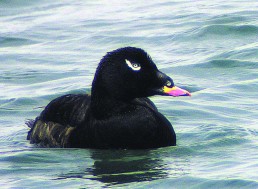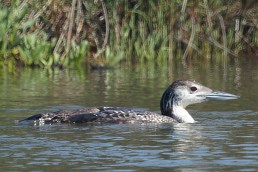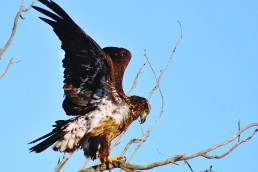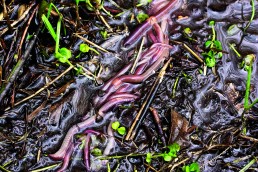Nature Notes
SHARE THIS POST
In winter, ‘turn turtle’
Hibernation means different things to different animals: some hardly sleep at all, while others are out cold until the warmth of spring arrives. For turtles, hibernation means spending months underwater, often beneath the ice. In fact, they spend their whole winter without ever surfacing. From time to time, ice fishermen see them down their holes. Without oxygen, one may wonder what is happening internally to a turtle that allows it to survive. They begin by digging down into the mud. From there, turtles slow their metabolic rate and heart rate to almost nothing. A turtle’s greatest challenge during this period is to prevent the buildup of lactic acid. To prevent this, turtles keep their metabolic rate just high enough to burn off some of the acid. The acid is a byproduct of their method of retrieving energy through the burning of certain sugars. Not all turtle species go through the same process in the winter, though. The described process occurs mostly in northern regions.
Hungry for some Hungarian?
Midwesterners are fortunate when it comes to the number of game birds available. One of the more unappreciated is the Hungarian or gray partridge. Gray partridge are comparable in size to bobwhite quail, with the partridge slightly larger. Partridge have a brown back, brown and gray checkered wings, a gray chest and neck and an orange head. Grays were brought to the U.S. in 1899, when 24 birds were transported from Hungary to Virginia. Since most of the original colonies of gray partridge were from Hungary, they were named the “Hungarian” partridge, even though the bird’s range is throughout much of Europe. Similar to other seed-eating upland birds, these partridges inhabit grain fields, preferring wheat. Within a field, “huns” choose sections where native shrubs connect with the cultivated species, and even more if there is water nearby.
Scoters scooting to Midwest now
As birds have long headed south for winter, it’s funny to think some “vacation” right here in the Midwest. A particular migratory bird vacations from the Great Lakes to the Atlantic Coast. White-winged scoters spend their breeding season all the way up in the Arctic Circle and other parts of Canada, only to end up overwintering along the Atlantic and Great Lakes. Because the scoter’s range is so far north, some spend their winters in Asia, even settling in China. It’s uncommon for white-winged scoters to end up as far southwest as Minnesota, but it happens. They are seen more frequently near Lake Michigan. For anyone who believes they have seen one, scoter drakes are all black, except for a small patch of white feathers on their wings with an upside checkmark around the eye. Their bills are orange on the side and front with white on top. Hens have white patches on their face rather than the upside-down checkmark, and the hen’s body color is more of brown than black. Viewing the scoter after their long journey is a cherished Midwestern birder experience.
Are you enjoying this post?
You can be among the first to get the latest info on where to go, what to use and how to use it!
Its fur as white as snow
As fall becomes winter, some animals change their pattern to relate to their new surroundings. The snowshoe hare is one. Though it’s a brown-furred animal most of the year, this hare changes white in the winter. They blend in well into their surroundings, so only the finest of predators locate them. Their coats go through the color metamorphosis as their eye’s perception of light levels. As the days become shorter, the snowshoe’s eyes no longer receive the same amount of sunlight. Because there is less light being received, parts of their brain reduce the amount of melanin being produced, in turn, causing the hare to become white. To prove the theory of light causing this change, scientists have gotten hares to change colors by shortening the amount of light received in captivity. This complex change is observed mostly in the very northern reaches of the Midwest.
Cats and cold-weather fishing
Catfishing is considered a summer thing—casting off sun-drenched banks like Huck Finn. Not only can you fish cats in the colder season, but the action also can sometimes be quite good. Catfish can be caught through the ice and in open segments of many rivers during winter, where they school together in deep holes. These fish might not be the most active on a riverbed, but if food presents itself, they won’t hesitate to eat. Food options become limited on account of their lethargy, so they tend to go for stationary foodstuffs, like mussels. When a catfish eats mussels, its digestive juices first kill the mussel, opening the shell. Once the meat is digested, the shell is passed. On some days in winter you can find schools of cats following the schools of shad, especially if there are consecutive days of much colder weather, causing die-offs.
Winter Woody Woodpecker
The challenges of winter affect many animals, and witnessing the way each species adapts to the seasons is incredible. Some change up their normal habits completely. The woodpecker, a bird that’s normally heard pounding away on trees or your house searching for insects, is a good example. But how do these normally carnivorous birds survive after the insects have all disappeared? These birds switch up their diet completely. Seeds and nuts become the primary food source for woodpeckers in winter. Their innate adjustments for food sources are enhanced through availability. Just add a suet cake or two to your winter-feeding mix and enjoy the arrival of the woodpeckers.
MWO
SHARE THIS POST
Did you enjoy this post?
You can be among the first to get the latest info on where to go, what to use and how to use it!
Calvin Vick
MidWest Outdoors’ “Nature Notes” columnist Calvin Vick is an undergraduate studying biology, with an emphasis on herpetology, at the University of Central Arkansas. His primary interests are venomous snakes and salamanders. He spends most of his free time photographing the two.



